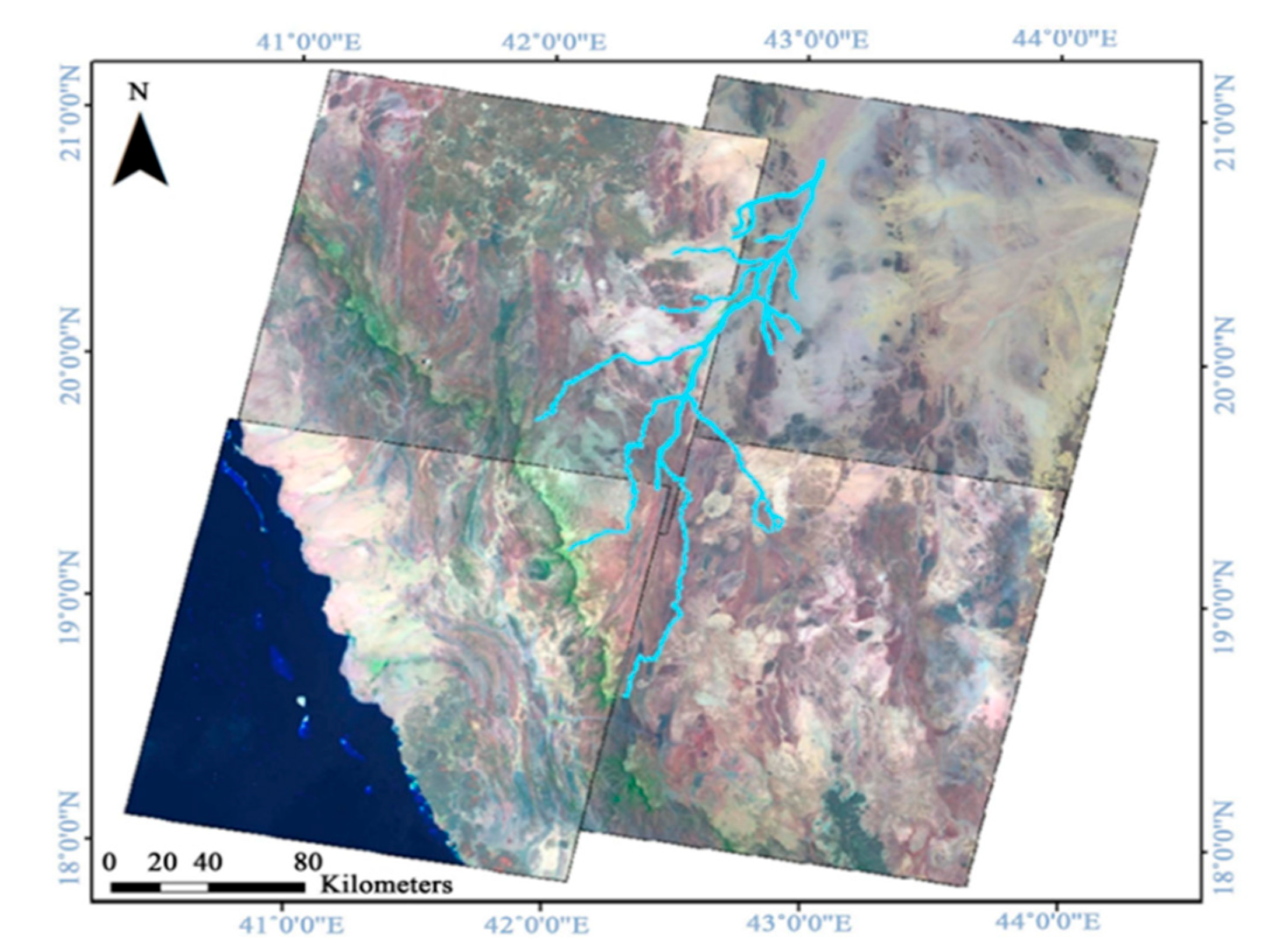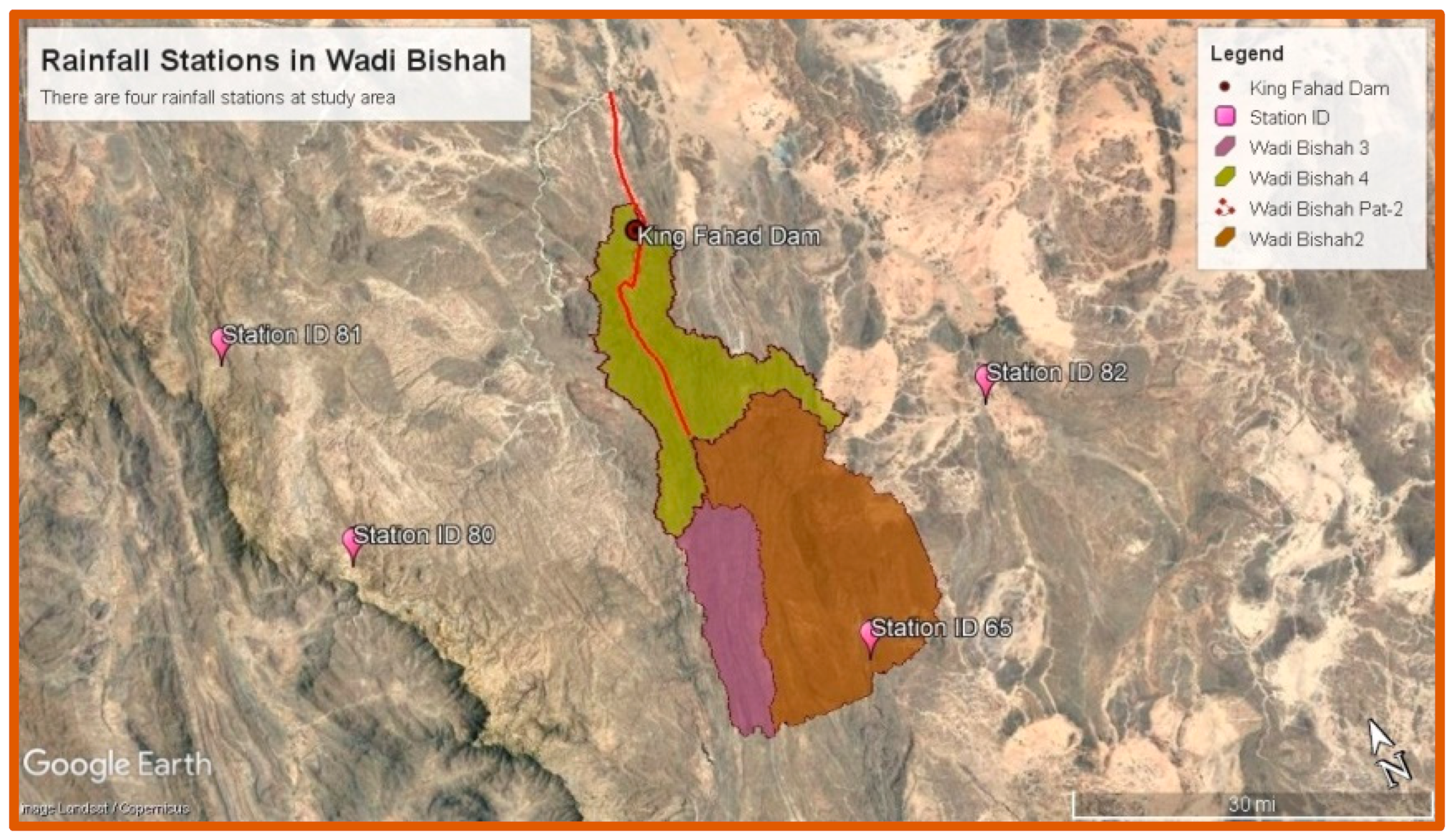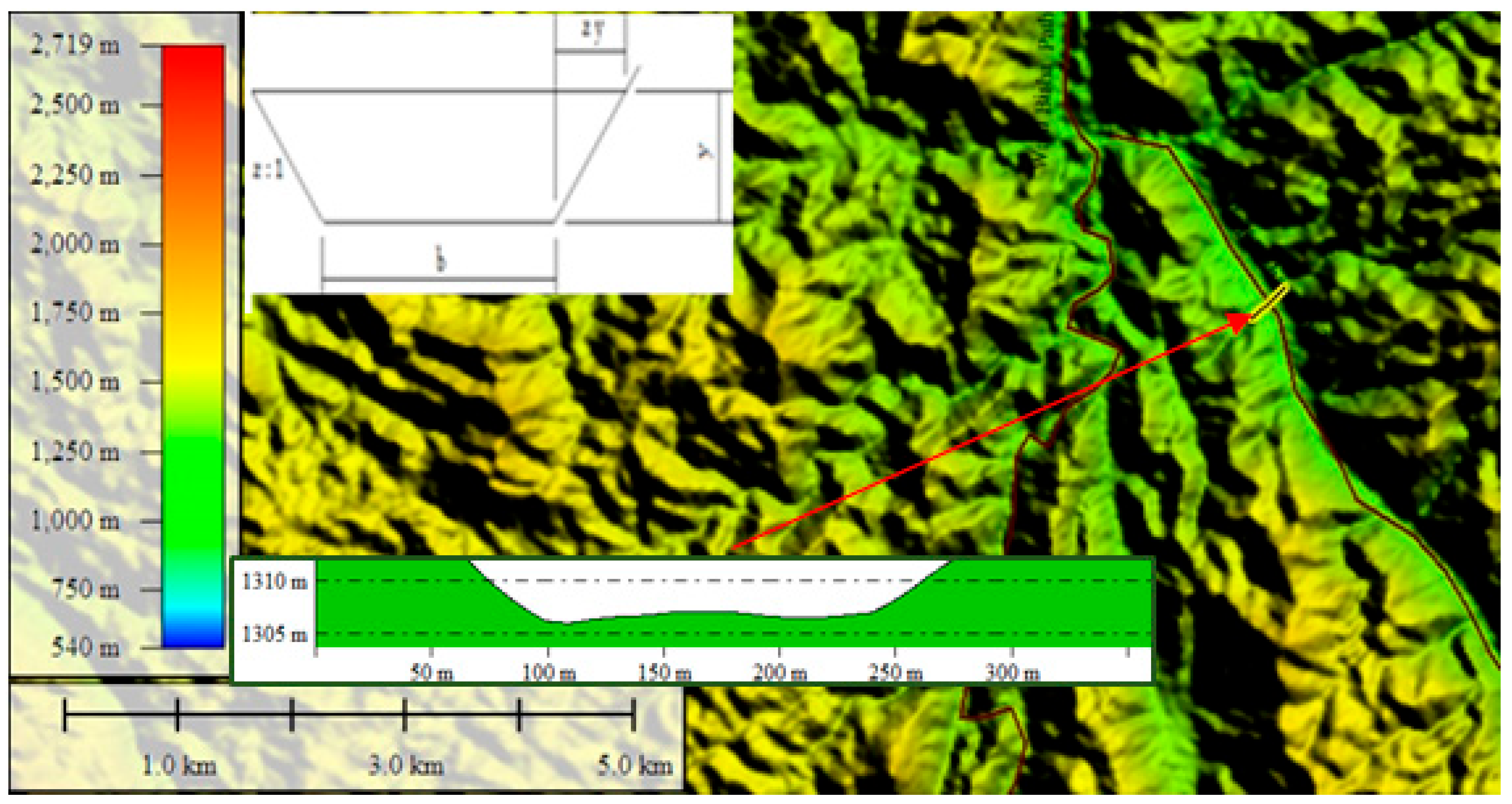Hydraulic Design of Sediment-Trapping Basin in Wadis Using Empirical Equations and Deposition Processes
Abstract
:1. Introduction
2. Materials and Methods
2.1. Study Area
2.2. King Fahd Dam
2.3. Rainfall Data
2.4. Proposed Location of Sediment-Trapping Basin
- The sediment-trapping basin should be at a location that is easy for maintenance and cleaning works.
- The sediment-trapping basin should be in an area with a large width to reduce the flow velocity.
- Satellite images should be used to select an optimum location for the trapping basin.
- The basin should be located in the mainstream to ensure that the sediments are collected from the minor streams.
2.5. Chezy’s Formula for Uniform Open-Channel Flow
2.6. Design Considerations of Trapping Basin Design
- It is preferable to consider the bed load as 10–15% of the suspended load.
- It is not required to trap fine particles, which are sediment particles smaller than 63 microns in size.
- The sediment-trapping basins are designed to trap the majority of the particle sizes greater than 0.063 mm, which includes fine sand and coarser materials such as gravel.
- Setting the minimum basin trap efficiency as 60–70%.
- The ratio of the basin length\width is maintained in the range of 4–10 as recommended.
- The fine particles such as silt and sand need to trap with the structure of a check dam.
2.6.1. Length of Settling Basin (
2.6.2. Surface Area of Settling Basin (As)
2.6.3. Width of Surface Area of Trapping Basin (Wb)
2.6.4. Trapping Basin Storage Volume of Sediments (Vs)
2.6.5. Sediment-Trapping Efficiency and Sediment Particles Sizes
3. Results of Hydraulic Design
3.1. Data Required for Sediment-Trapping Basin Design
- (1).
- Geometric Data
- (2).
- Hydraulic Data
- (3).
- Sediment Data Collected and Analysis
3.1.1. Sediment Data
- -
- The flow duration curve (FDC).
- -
- The sediment-rating curves (SRC).
3.1.2. Hydraulic Data
- A.
- Calculating the Flow Velocity
- B.
- Design Flows Wadi Bishah (Qdesign)
3.1.3. Collection of Sediment Data and Analysis
- A.
- Sediment Gradation:
- B.
- Total Sediment Load Entering the Trapping Basin

3.2. Hydraulic Design of Sediment-Trapping Basin
- A.
- Length of Settling Basin (:
- B.
- Surface Area of Settling Basin (As)
- C.
- Width of Surface Area of Trapping Basin (Wb)
- D.
- Minimum Depth of Trapping Basin (hs)
- E.
- Trapping Basin Storage Volume of Sediments (Vs)
4. Discussions
5. Conclusions
Author Contributions
Funding
Data Availability Statement
Acknowledgments
Conflicts of Interest
Abbreviations
| WCD | World Commission on Dams |
| GIS | Geographical Information System |
| U/S | Upstream |
| D/S | Downstream |
| SRH-1D | Sedimentation and River Hydraulics—One Dimension |
| CCHE2D | Center for Computational Hydro science and Engineering Two Dimension |
| MOEAW | Ministry of Water, Environment and Agriculture |
| USGS | United States Geological Survey |
| DEM | Digital Elevation Model |
| DMR | Daily Maximum Rainfall |
| AMSL | Above Mean Sea Level |
| FDC | Flow Duration Curve |
| SRC | Sediment-Rating Curves |
| AGUS | Unified Soil Classification System |
| MOWE | Ministry of Water and Electricity |
| DSF | Daily Suspended Flow |
| SSD | Daily Suspended Sediment |
| SL | Suspended load |
| BL | Bed Load |
| BM | Bed Material Load |
| TSS | Total Suspended Solids |
| SSC | Suspended Sediment Concentration |
| FISP | Federal Interagency Sedimentation Project |
| NTU | Nephelometric Turbidity Unit |
References
- Schleiss, A.J.; Franca, M.J.; Juez, C.; De Cesare, G. Reservoir sedimentation. J. Hydraul. Res. 2016, 54, 595–614. [Google Scholar] [CrossRef]
- WCD. Dams and Development: A New Framework for Decision-Making; Earth Scan Publications Ltd.: London, UK, 2000; 356p. [Google Scholar]
- Adamo, N.; Al-Ansari, N.; Sissakian, V.; Laue, J.; Knutsson, S. Dam safety: Sediments and debris problems. J. Earth Sci. Geotech. Eng. 2021, 11, 27–63. [Google Scholar] [CrossRef] [PubMed]
- Linsley, R.K.; Franzini, J.B. Water Resources Engineering; McGraw Hill: New York, NY, USA, 1979; 688p. [Google Scholar]
- Ezz-Aldeen, M.; Hassan, R.; Ali, A.; Al-Ansari, N.; Knutsson, S. Watershed sediment and its effect on storage Capacity: Case Study of Dokan Dam Reservoir. Water 2018, 10, 858. [Google Scholar] [CrossRef]
- ICOLD. Selecting Parameters for Large Dams—Guidelines and Recommendations: ICOLD Committee on Seismic Aspects of Large Dams, Bulletin; International Commission on Large Dams: Paris, France, 1989; Volume 72, p. 36. [Google Scholar]
- Aldrees, A.; Bakheit, A.T.; Assilzadeh, H. Prediction of total sediment load: A case study of Wadi Arbaat in eastern Sudan. Smart Struct. Syst. 2020, 26, 781–796. [Google Scholar] [CrossRef]
- Zeleke, T.; Moussa, A.M.; El-Manadely, M.S. Prediction of sediment inflows to Angereb dam reservoir using the SRH -1D sediment transport model. Lakes Reserv. Res. Manag. 2013, 18, 366–371. [Google Scholar] [CrossRef]
- Moussa, A.M.A. Predicting the deposition in the Aswan High Dam Reservoir using a 2-D model. Ain Shams Eng. J. 2013, 4, 143–153. [Google Scholar] [CrossRef]
- Morris, G.L.; Fan, J. Reservoir Sedimentation Handbook; McGraw-Hill Book Company: New York, NY, USA, 1997; 784p. [Google Scholar]
- Mizuyama, T. Structural Countermeasures for Debris Flow Disasters. Int. J. Eros. Control. Eng. 2008, 1, 38–43. [Google Scholar] [CrossRef]
- Pimentel, D. Soil Erosion and the Threat to Food Security and the Environment. Ecosyst. Health 2000, 6, 221–226. [Google Scholar] [CrossRef]
- Vanoni, V.A. (Ed.) Sedimentation Engineering: American Society of Civil Engineers, Manuals and Reports on Engineering Practice; American Society of Civil Engineers (ASCE): New York, NY, USA, 1975; No. 54; 745p. [Google Scholar]
- Iyer, J.C.; James, E.J. Model studies for the design of inlet transition of settling basins of hydropower projects in high sediment yield areas: A review. ISH J. Hydraul. Eng. 2022, 29, 351–359. [Google Scholar] [CrossRef]
- Zhang, X.; She, D. Quantifying the sediment reduction efficiency of key dams in the Coarse Sandy Hilly Catchments region of the Yellow River basin, China. J. Hydrol. 2021, 602, 126721. [Google Scholar] [CrossRef]
- Elfiky, M.M.; Nassar, M.A.; Elnikhely, E.A. Numerical Modeling of Sedimentation process in Settling Basins (Case Study Tana River). In Proceedings of the VII International Conference on Environmental Hydrology & Its Engineering Aspect and the First Symposium—Environmental Impacts on Nile Water Resources, Cairo, Egypt, 25–27 September 2012. [Google Scholar]
- Paschmann, C.; Vetsch, D.F.; Boes, R.M. Design of Desanding Facilities for Hydropower Schemes Based on Trapping Efficiency. Water 2022, 14, 520. [Google Scholar] [CrossRef]
- Mathers, K.L.; Kowarik, C.; Rachelly, C.; Robinson, C.T.; Weber, C. The effects of sediment traps on instream habitat and macro invertebrates of mountain streams. J. Environ. Manag. 2021, 295, 113066. [Google Scholar] [CrossRef] [PubMed]
- Alshaikh, A. Vegetation cover density and land surface Temperature Interrelationship Using Satellite Data, Case Study of Wadi Bisha, South KSA. Adv. Remote. Sens. 2015, 4, 248–262. [Google Scholar] [CrossRef]
- Chow, V.T. Open Channel Hydraulics; McGraw Hill Book Company: New York, NY, USA, 1959. [Google Scholar]
- Camp, T.R. Sedimentation and the design of settling tanks. Trans. Am. Soc. Civ. Eng. 1946, 111, 895–936. [Google Scholar] [CrossRef]
- Van Rijn, L.C. Mathematical modeling of Morphological Processes in the case of Suspended Sediment Transport. Delft Hydraul. Commun. 1987, 382. [Google Scholar]
- Piton, G.; Recking, A. Design of sediment traps with open check dams. I: Hydraulic and deposition processes. J. Hydraul. Eng. 2016, 142, 04015045. [Google Scholar] [CrossRef]
- Arcement, G.J.; Schneider, V.R. Guide for Selecting Manning’s Roughness Coefficients for Natural Channels and Flood Plains; US Government Printing Office: Washington, DC, USA, 1989.
- Ministry of Electricity and Water (The Ministry of Environment, Water and Agriculture); General Directorate of Projects Execution Department (Investigations, Studies and Detailed Design for Surface Dam on Wadi Bishah). The Final Report for Design the Bishah Dam (Hard Copy); Ministry of Electricity and Water (The Ministry of Environment, Water and Agriculture): Riyadh, Saudi Arabia, 1983; Volume 1. [Google Scholar]












| Reservoir Data of King Fahad Dam | |
|---|---|
| Maximum Reservoir Level | 1315.70 m above sea level (a.s.l) |
| Reservoir Level for Dead Storage | 1283.00 m above sea level (a.s.l) |
| Maximum Reservoir Volume | 325 × 106 m3 |
| Reservoir Volume for Flood Control | 252 × 106 m3 |
| Dead Storage Volume | 73 × 106 m3 |
| Details of King Fahad Dam | |
| Type | Concrete Gravity Dam |
| Crest Elevation | 1318.00 m above sea level (a.s.l) |
| Crest Width | 6 m |
| Crest Length | 507.00 m |
| River Bed Elevation | 1250.00 m above sea level (a.s.l) |
| Foundation Elevation | 1205.00 m above sea level (a.s.l) |
| Height from Bed Level | 68 m |
| Total Volume of Concrete | 1,492,000 m3 |
| No. | M. Station | Coordinates | Altitude (m) | Data Period | Region | |
|---|---|---|---|---|---|---|
| Longitude (°) E | Latitude (°) N | |||||
| 1. | Station 65 | 42°31′60.00″ | 19°51′60.00″ | 1607 | 1965–2018 | Asir |
| 2. | Station 82 | 42°48′0.00″ | 19°19′60.00″ | 1477 | 1965–2018 | Asir |
| 3. | Station 80 | 41°58′60.00″ | 19°27′60.00″ | 2249 | 1965–2018 | Asir |
| 4. | Station 81 | 41°55′60.00″ | 19°45′0.00″ | 1759 | 1965–2018 | Asir |
| Basic Statistics of Rainfall Data | |
|---|---|
| No. of observations (year) | 56 |
| Minimum (mm) | 0 |
| Maximum (mm) | 190.4 |
| Average (mm) | 64 |
| Standard deviation (S.D) (mm) | 50.7 |
| Median (mm) | 52.6 |
| Coefficient of variation (Cv) | 0.793 |
| Skewness coefficient (Cs) | 0.773 |
| Kurtosis coefficient (Ck) | 2.67 |
| Station | Period Survey | Number of Measurements | Maximum of SSC (mg/L) |
|---|---|---|---|
| A-403, Hashbel | 14.5.1973–14.6.1973 | 4 | 6700 |
| A-402, Hashbel | 29.4.1972–16.5.1973 | 32 | 29,400 |
| A-406, Hashbel | 15.3.1972–16.5.1973 | 22 | 86,800 |
| SSC= 6700 mg/L | |||
| Type of Sediment Materials | Description | Sediment Size Range (mm) |
|---|---|---|
| Gravel | Very coarse gravel | 64–32 |
| Coarse gravel | 32–16 | |
| Medium gravel | 16–8 | |
| Fine gravel | 8–4 | |
| Very fine gravel | 4–2 | |
| Sand | Very coarse sand | 2.0–1.0 |
| Coarse sand | 1.0–0.5 | |
| Medium sand | 0.5–0.25 | |
| Fine sand | 0.25–0.125 | |
| Very fine sand | 0.125–0.062 | |
| Silt | Coarse silt | 0.062–0.031 |
| Medium silt | 0.031–0.016 | |
| Fine silt | 0.016–0.008 | |
| Very fine silt | 0.008–0.004 | |
| Clay | Coarse clay | 0.004–0.002 |
| Medium clay | 0.002–0.001 | |
| Fine clay | 0.0010–0.0005 | |
| Very fine clay | 0.0005–0.00024 |
| Type of Sediment | Range of Grain Size (mm) | Percentage (%) | New Percentage (%) | ||
|---|---|---|---|---|---|
| Upper Limit | Lower Limit | Average (d Average) | |||
| Clay | 0.004 | 0.002 | 0.003 | 20 | 30 |
| Silt | 0 062 | 0 031 | 0.03 | 10 | |
| Fine sand | 0.0625 | 0.25 | 0.13 | 30 | 70 |
| Medium sand | 0.25 | 0.5 | 0.375 | 10 | |
| Coarse sand | 1.0 | 0.5 | 0.75 | 10 | |
| Fine gravel | 8 | 4 | 6 | 20 | |
| Medium gravel | 16 | 8 | 12 | ||
| Coarse gravel | 32 | 16 | 24 | ||
| Ray 1 | Ray 2 | Ray 3 | Ray 4 | Ray 5 | Ray 6 | |
|---|---|---|---|---|---|---|
| % Time Increment | Time Increment | Average of Time Increment | Daily Flow (Qflow) | D.S.F (Qs) | S.S.D for Time Increment | |
| % | Δ% | % | m3/s | Ton/day | Ton | |
| 1. | 0.02 | 0.02 | 0.01 | 0 | 0 | 0 |
| 2. | 0.1 | 0.08 | 0.06 | 270 | 155,574 | 124.4592 |
| 3. | 0.2 | 0.10 | 0.15 | 540 | 311,148 | 311.148 |
| 4. | 0.5 | 0.30 | 0.40 | 810 | 466,722 | 1400.166 |
| 5. | 1.0 | 0. 5 | 0.75 | 1080 | 622,296 | 3111.48 |
| 6. | 2.0 | 1.0 | 1.5 | 1350 | 777,870 | 7778.7 |
| 7. | 3.0 | 1.0 | 2.5 | 1620 | 933,444 | 9334.44 |
| 8. | 5.0 | 2.0 | 4.0 | 1890 | 1,089,018 | 21,780.36 |
| 9. | 9.0 | 4.0 | 7.0 | 2160 | 1,244,592 | 49,783.68 |
| 10. | 15.0 | 6.0 | 12.0 | 2688 | 1,548,825.6 | 92,929.536 |
| 11. | 25.0 | 10.0 | 20.0 | 2388 | 1,375,965.6 | 137,596.56 |
| 12. | 35.0 | 10.0 | 30.0 | 2088 | 1,203,105.6 | 120,310.56 |
| 13. | 45.0 | 10.0 | 40.0 | 1788 | 1,030,245.6 | 103,024.56 |
| 14. | 55.0 | 10.0 | 50.0 | 1488 | 857,385.6 | 85,738.56 |
| 15. | 65.0 | 10.0 | 60.0 | 1188 | 684,525.6 | 68,452.56 |
| 16. | 75.0 | 10.0 | 70.0 | 908 | 523,189.6 | 52,318.96 |
| 17. | 85.0 | 10.0 | 80.0 | 628 | 361,853.6 | 36,185.36 |
| 18. | 95.0 | 10.0 | 90.0 | 358 | 206,279.6 | 20,627.96 |
| 19. | 99.0 | 4.0 | 97.5 | 90 | 51,858 | 2074.32 |
| 20. | 99.8 | 0.8 | 99.4 | 40 | 23,048 | 184.384 |
| Total | 99.8 | - | - | - | 813,067.7532 | |
| ||||||
| Type of Sediment | Particle size (ds) | Percentage (m) | Annual Quantities (Ton/Year) | Rate (m3/km2/year) | Trap Efficiency ® (%) |
|---|---|---|---|---|---|
| Clay | 0.003 | 20 | 364,626.0416 | 47.977 | 30%→71.966 |
| Silt | 0.03 | 10 | 182,313.0208 | 23.989 | |
| Fine sand | 0.13 | 30 | 546,939.0624 | 71.966 | 70%→167.921 |
| Medium sand | 0.5 | 10 | 182,313.0208 | 23.989 | |
| Coarse sand | 1 | 10 | 182,313.0208 | 23.989 | |
| Fine gravel | 6 | 20 | 364,626.0416 | 47.977 | |
| Total | 100% | 1,823,130.208 | 239.887 | 71.966 + 71.966 | |
| Particle Type | D (mm) | Us (m/s) | Time | Uent (m/s) | Lb (m) | AS (m) | Wb (m) | Ainflow (m2) |
|---|---|---|---|---|---|---|---|---|
| Coarse silt | 0.062 | 0.0023 | 9 min | 0.11 | 4007.6 | 1,418,696 | 333 | 752.25 |
| Description | (m) | (m) | Area(m2) | Q Peak (m3/s) | Design Velocity (m/sec) | hs(m) | ||
| Basin | 3500 | 500 | 2688 | 4 | 1.5 | |||
Disclaimer/Publisher’s Note: The statements, opinions and data contained in all publications are solely those of the individual author(s) and contributor(s) and not of MDPI and/or the editor(s). MDPI and/or the editor(s) disclaim responsibility for any injury to people or property resulting from any ideas, methods, instructions or products referred to in the content. |
© 2023 by the authors. Licensee MDPI, Basel, Switzerland. This article is an open access article distributed under the terms and conditions of the Creative Commons Attribution (CC BY) license (https://creativecommons.org/licenses/by/4.0/).
Share and Cite
Taha, A.T.B.; Aldrees, A.; Moussa, A.M.A. Hydraulic Design of Sediment-Trapping Basin in Wadis Using Empirical Equations and Deposition Processes. Processes 2023, 11, 2729. https://doi.org/10.3390/pr11092729
Taha ATB, Aldrees A, Moussa AMA. Hydraulic Design of Sediment-Trapping Basin in Wadis Using Empirical Equations and Deposition Processes. Processes. 2023; 11(9):2729. https://doi.org/10.3390/pr11092729
Chicago/Turabian StyleTaha, Abubakr Taha Bakheit, Ali Aldrees, and Ahmed Moustafa Ahmed Moussa. 2023. "Hydraulic Design of Sediment-Trapping Basin in Wadis Using Empirical Equations and Deposition Processes" Processes 11, no. 9: 2729. https://doi.org/10.3390/pr11092729







